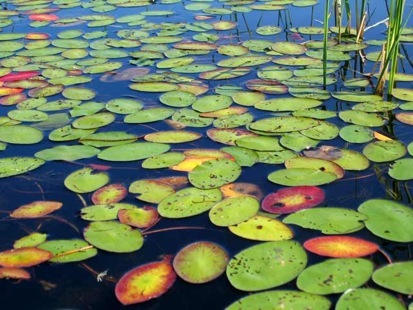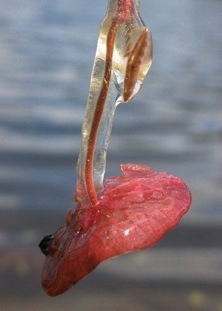
Water Shields, note oval in shape, no slit
Brasenia schreberi: Palatable Pond Weed
The Water Shield is edible. The problem is getting it sometimes. It likes water … up to six feet deep. On the good side, this is one aquatic plant that is found throughout all of North America and is edible from top to bottom.
On first glance it is easy to mistake the Water Shield (Brasenia schreberi) for a young Nuphar lutea, or yellow pond lilly. They like similar wet environs. However, the Water Shield does not have a split leaf and the Nuphar does, or at least notched. Also, the stem of the Water Shied attaches to the middle of the oval floating leaf. I say floating so you don’t get it confused with the American lotus, which also has a round leaf with the stem attached in the middle. However, the lotus has leaves out of water whereas the Water Shield leaf is always floating.

The Water Shield always has clear gel on leaf and stem
The Water Shield can also be confused with the Fragrant Water Lily, Nymphaea odorata, or Floating Hearts, Nymphoides peltata, and several pond weeds such as the Potamogeton. But only the Water Shield is covered by a clear gel coating on the underside of the leaf and stem. Remember you are looking for an oval, floating leaf with the stem attached to the middle, no clef AND the leaf and stem have a gel coating.
The creeping rhizomes and young leaves were used for food by Native Americans. The Japanese use the young leaves and stems in salads and miso soup. The starchy roots can be peeled, boiled and eaten or dried and stored or dried then ground into flour. But they must be peeled or they are too bitter to eat. Nutritionally per 100g weight the Water Shield has 135 calories and is 9.5% protein; 2.7% fat; has 24.3 carbs; 1.4 grams fiber; 122 mg of calcium; 311 mg phosphorus; 27 mg Iron:; Vitamin A; 27 mg; thiamine; 135 mg; niacin, 0.41; vitamin C, 0.5 mg.
The Water Shield is also a habitat for fish and aquatic insects. Where there is Water Shield there is usually good fishing. Its seeds and vegetation are eaten by waterfowl. While found throughout most of North American including Alaska it’s also found in Central America, Cuba, Africa, East Asia and Australia.
The Brasenia (bruh-SE-nia) genus is named for Christoph Brasen, 1774, a Moravian missionary and plant collector in Greenland and Labrador. Schreberi, (shri-BER-ee) is Latin for, “of Schreber, or Schreber’s”. It is named for German botanist Johann Christian Daniel von Schreber (1739-1810), a student of Linnaeus.
Green Deane’s “Itemized” Plant Profile
IDENTIFICATION: Water Shield leaves are oval with long, reddish leaf stalks are attached at the centers of the leaves. Its submersed parts and undersides covered with a jelly-like substance, flowers are small, dull purple, and emerge from the water on a stalk. They are not showy.
TIME OF YEAR: Best time to collect the roots is autumn to spring, leaves when young
ENVIRONMENT: Shallow ponds, lakes, slow-moving streams to six feet deep. Make sure the water is wholesome.
METHOD OF PREPARATION: Young leaves and stems raw or cooked, roots peeled, boiled and or dried and ground into flour.


Fantastic website! Is the goo on the leaves and stems edible?
Not harmful but usually is not eaten.
Yes . It’s a Japanese delicacy
What exactly is that gel anyways?
Chemically? I don’t know but the plant oozes it to protect itself.
Hello,
I remember this was a gourmet ingredient for Japanese dish.
Do you know where I can buy this plant or seeds?
Thank you.
I’ll give you all you can carry,everyday of your life.My pond is full of it. Spring fed.
Any chance you could mail some to me?
Green Dean, we are trying to get a lot of the water shield out of our pond. Do you think I could compost the harvested plants in my garden?
Absolutely. Water shield, like other aquatic plants, is a great addition to compost piles, especially when composting dry leaves or wood chips. The plants are wet, they quickly disintegrate out of the water, and are pretty high in protein, so should add some N. A pile of just water shield plants will look like a small pile of dirt in a couple of weeks, at most. I suppose you should make sure that your water shield pond is not accumulating some toxin, but otherwise composting should be fine.
I’m surprised why people aren’t packaging this stuff and selling them! I for one would LOVE to see this sold in (Asian/mainstream) supermarkets and enjoyed with a nice, clear broth!
Also if anyone knows where to get them in the Greater Toronto Area, I’d love to get some…
certainly like your web site but you need to check the spelling on several of your posts. Many of them are rife with spelling issues and I find it very bothersome to tell the truth nevertheless I will surely come back again.
My spelling errors kept you reading…and it guarantees that my material is not written by AI or grammerly, it is all mine, I wrote every word in the cite (allowing for properly cited comments.).